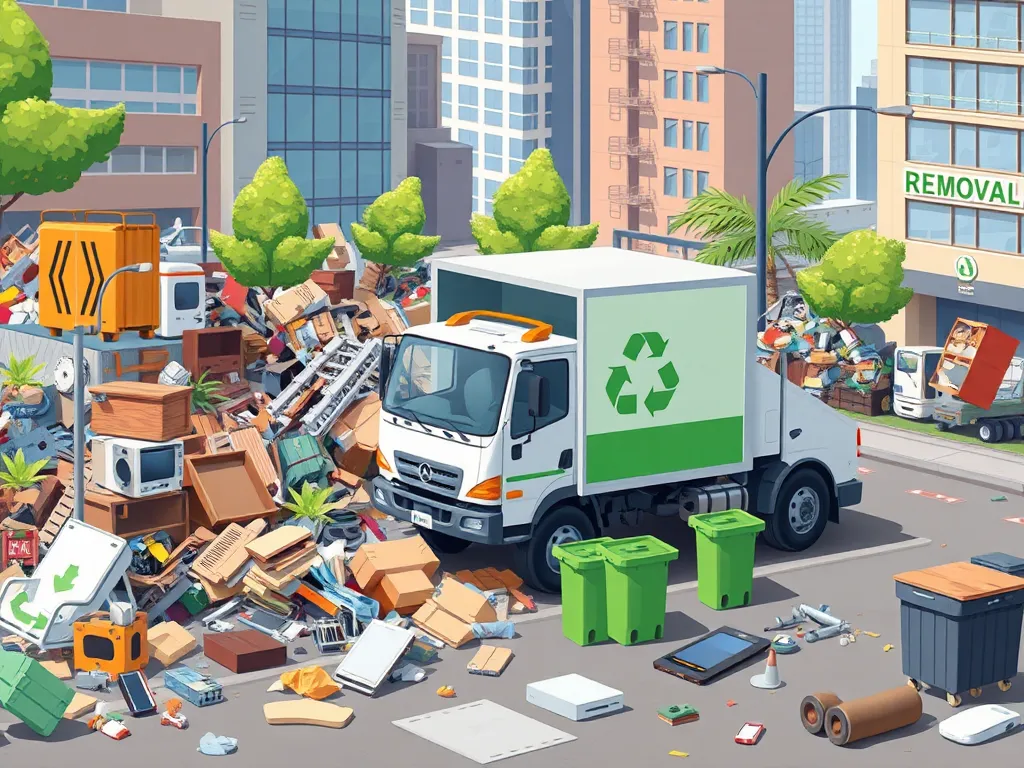Exploring Trends in the Junk Removal Industry for 2023

Trends in Junk Removal Industry
The junk removal industry has witnessed significant transformations over the years, driven by evolving consumer demands, environmental concerns, and technological advancements. As more people become aware of the importance of decluttering their spaces, the trends in junk removal industry are shifting toward more efficient, eco-friendly solutions, aligning with the values of modern consumers. This article will explore the key trends shaping the future of the junk removal industry and how businesses can capitalize on these changes.
One of the most notable trends in junk removal industry is the growing emphasis on environmental sustainability. Companies are increasingly adopting practices that reduce waste and promote recycling. With more stringent regulations surrounding waste management, service providers are required to rethink their strategies, ensuring that a significant portion of the material they collect is diverted from landfills. This shift is not only beneficial for the environment but also resonates with consumers who are increasingly prioritizing eco-friendly options when choosing service providers.
Technological advancements also play a crucial role in the trends in junk removal industry, transforming how services are booked and delivered. The rise of mobile applications has made it easier for consumers to schedule pickups from their smartphones, while innovations in waste sorting technologies have improved the efficiency of recycling processes. Automation is also beginning to impact junk removal operations, providing companies with tools to optimize routes and reduce operational costs while enhancing customer satisfaction.
Business models within the junk removal sector are evolving, reflecting changes in consumer behavior and market dynamics. From franchising opportunities to independent service providers, companies are exploring various avenues to expand their reach and customer base. Pricing strategies are becoming more competitive due to increased market saturation, leading to creative approaches such as service bundling and customer loyalty programs. Moreover, the emergence of subscription-based services is offering consumers a predictable and convenient option for regular junk removal needs.
Understanding market trends and consumer behavior is essential for businesses looking to thrive in the junk removal industry. As urbanization continues to reshape demographics, junk removal providers must adapt to changing customer preferences and expectations. The influence of social media is also significant, with platforms assisting consumers in selecting services based on real-time feedback and reviews. By keeping a pulse on these market trends, businesses can better tailor their offerings to meet the needs of their target audience.
Researchers have identified several key insights regarding Emerging trends in informal sector recycling in developing and transition countries, highlighting their impact on sustainable development.
Environmental Sustainability in Junk Removal
Recycling practices have become a focal point within the junk removal industry, with many companies implementing robust recycling programs as part of their operational processes. These initiatives not only contribute to waste reduction but also help businesses build a reputation for being environmentally responsible. By partnering with local recycling facilities and ensuring proper sorting of materials, junk removal services can effectively increase the amount of waste diverted from landfills.
Waste reduction strategies are increasingly adopted by junk removal companies to minimize their environmental footprint. These strategies may involve reusing items collected, donating usable goods, or promoting decluttering as a way to foster more sustainable consumption habits among consumers. By implementing such strategies, companies not only comply with regulations but also appeal to the growing eco-conscious consumer base.
Eco-friendly disposal methods are gaining traction in the junk removal industry as consumers demand greener options. This shift includes utilizing biodegradable materials, eco-safe cleaning products, and methods that minimize carbon emissions during operations. Incorporating eco-friendly disposal methods not only aligns with environmental efforts but also enhances company branding and consumer trust.
The impact of environmental regulations is a driving force behind trends in junk removal industry. Governments across the globe are instituting more rigorous policies to manage waste effectively, pushing companies to adapt align their operations with these legal requirements. Compliance not only reduces legal risks for junk removal businesses but also positions them as responsible corporate citizens in the eyes of the community.
Consumer demand for green services is undeniably reshaping the landscape of junk removal. As people become more mindful of their ecological impact, they actively seek companies that prioritize sustainability. Junk removal providers that adopt green practices and transparently communicate these initiatives to their customers are likely to see increased loyalty and satisfaction in their clients.
Technological Advancements in Junk Removal
The use of mobile applications for booking services is revolutionizing the junk removal industry. These apps enable consumers to effortlessly schedule pickups, receive estimates, and track service providers in real time. This convenience meets the expectations of today's fast-paced world, making it easier to access junk removal services at any time.
Innovations in waste sorting technology are streamlining operations for junk removal companies. Automated systems that accurately categorize materials are reducing human error and increasing the efficiency of recycling efforts. These innovations are pivotal in ensuring that a larger percentage of waste is processed appropriately, minimizing the burden on landfills.
Automation in junk removal processes is enhancing operational efficiency and enabling service companies to manage resources better. By employing automated routing systems, garbage trucks can optimize their routes based on traffic conditions and customer locations, leading to quicker service and reduced fuel consumption.
Online marketing trends are also shaping how junk removal services reach potential customers. Social media advertising, search engine optimization (SEO), and local marketing strategies are becoming integral components of business growth. Effectively leveraging these marketing tactics can help junk removal providers establish a strong online presence and attract more clients.
Data analytics is emerging as a critical tool for operational efficiency in junk removal. By analyzing customer data and operational patterns, companies can identify opportunities for improvement, optimize pricing strategies, and enhance service delivery. This data-driven approach ensures that junk removal providers not only meet consumer needs but also stay ahead of the competition.
Business Models in Junk Removal
In the junk removal industry, businesses face the choice of franchising versus operating independently. Franchising allows for established brands to expand rapidly by capitalizing on the expertise and systems of well-known companies, while independent operators may have greater flexibility and control over their operations and customer relationships.
Pricing strategies in a competitive junk removal market require strategic thinking. Companies must balance competitive pricing with sustainable profit margins, while also considering the costs associated with eco-friendly practices. Creative pricing models can differentiate a company from its competitors, drawing in more customers.
Service bundling for increased value is a trend gaining traction in junk removal businesses. By offering customers packages that include multiple services—such as heavy item removal and eco-friendly disposal options—companies can attract a wider range of clients while maximizing revenue per job.
Customer loyalty programs are becoming vital in the junk removal industry as businesses seek to retain customers in a crowded marketplace. Offering incentives, discounts, or rewards for repeat business strengthens relationships and encourages customers to choose the same service provider for their future junk removal needs.
The emergence of subscription-based services is revolutionizing how customers approach junk removal. This model allows consumers to subscribe for regular pickups, providing them with predictable service and helping businesses maintain steady revenue streams. It aligns with the growing desire for convenience and makes it easy for consumers to manage their clutter.
Market Trends and Consumer Behavior
Understanding consumer preferences is fundamental for junk removal companies aiming to tailor their services effectively. As consumers become more conscious of the environmental impact of their waste, they are likelier to choose services offering sustainable options. This heightened awareness is pushing the industry toward greener practices.
The effect of urbanization on junk removal needs is evident as more people migrate to urban areas. Denser populations lead to increased waste generation, necessitating more efficient junk removal services. As a result, companies operating in urban settings must adapt their offerings to meet the growing demand.
Shifts in demographic trends are influencing the junk removal industry. Emerging consumer segments, such as millennials and Gen Z, prioritize sustainability and convenience, affecting their buying preferences. Companies that can identify and cater to these demographic shifts are more likely to succeed.
The influence of social media on service choice has become paramount in recent years. Consumers are now using platforms like Facebook and Instagram to research services, read reviews, and share their experiences. Junk removal companies need to maintain a strong social media presence to engage with potential clients and build their reputations.
Customer feedback and service improvement is a vital aspect of business growth in the junk removal industry. Soliciting reviews and actively responding to client feedback provides valuable insights to drive improvements and create customer satisfaction. By prioritizing customer feedback, companies can continuously evolve and enhance their service offerings.
Challenges and Opportunities in the Industry
Regulatory challenges impacting operations can pose significant hurdles for junk removal companies. Keeping up with evolving regulations around waste management, recycling, and environmental practices requires constant vigilance and investment in compliance, which can strain resources.
Rising competition among providers is creating a challenging landscape for junk removal businesses. As more companies enter the market, established players must continuously innovate and differentiate their services to retain their competitive edge.
Managing operational costs effectively is crucial for success in the junk removal industry. Companies must find ways to minimize costs while maintaining service quality, especially amid fluctuating demand. Implementing efficient processes and leveraging technology can aid in achieving this balance.
Adapting to economic fluctuations is another challenge that junk removal providers face. Economic downturns can lead to decreased spending on non-essential services like junk removal. Businesses that diversify their offerings and develop pandemic-proof strategies stand a better chance of weathering such fluctuations.
Exploring new markets and niches can present significant opportunities for junk removal businesses. Companies that identify underserved demographic groups or geographical areas can tap into new revenue streams while meeting the needs of their communities.
